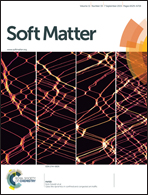Lysozyme adsorption in pH-responsive hydrogel thin-films: the non-trivial role of acid–base equilibrium†
Abstract
We develop and apply a molecular theory to study the adsorption of lysozyme on weak polyacid hydrogel films. The theory explicitly accounts for the conformation of the network, the structure of the proteins, the size and shape of all the molecular species, their interactions as well as the chemical equilibrium of each titratable unit of both the protein and the polymer network. The driving forces for adsorption are the electrostatic attractions between the negatively charged network and the positively charged protein. The adsorption is a non-monotonic function of the solution pH, with a maximum in the region between pH 8 and 9 depending on the salt concentration of the solution. The non-monotonic adsorption is the result of increasing negative charge of the network with pH, while the positive charge of the protein decreases. At low pH the network is roughly electroneutral, while at sufficiently high pH the protein is negatively charged. Upon adsorption, the acid–base equilibrium of the different amino acids of the protein shifts in a nontrivial fashion that depends critically on the particular kind of residue and solution composition. Thus, the proteins regulate their charge and enhance adsorption under a wide range of conditions. In particular, adsorption is predicted above the protein isoelectric point where both the solution lysozyme and the polymer network are negatively charged. This behavior occurs because the pH in the interior of the gel is significantly lower than that in the bulk solution and it is also regulated by the adsorption of the protein in order to optimize protein–gel interactions. Under high pH conditions we predict that the protein changes its charge from negative in the solution to positive within the gel. The change occurs within a few nanometers at the interface of the hydrogel film. Our predictions show the non-trivial interplay between acid–base equilibrium, physical interactions and molecular organization under nanoconfined conditions, which leads to non-trivial adsorption behavior that is qualitatively different from what would be predicted from the state of the proteins in the bulk solution.


 Please wait while we load your content...
Please wait while we load your content...